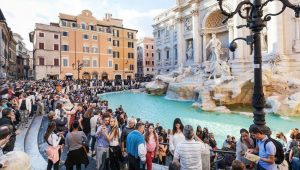Introduction
As the world battles with the ongoing Covid-19 pandemic and faces the challenges it has brought, there is no better time to begin rethinking and reshaping the future. Recovery of the travel industry might take longer than we imagine but what is certain is that the industry will never be the same and the challenge of sustainability has not vanished. Global CO2 emissions have decreased due to restrictions on travel, yet it is only temporary change for the better. Despite the negative effects of this world situation, it can be viewed as an opportunity. DMOs can use this time to reinvent themselves and create new ways to do marketing. This is the time to take a more responsible and honest approach in destination marketing, be transparent about the poverty, pollutions, and glossy images that are used to trick tourists to create sales.
Challenges
Due to the obvious, people have become fearful and in the need for assurance when it comes to traveling (Augustenborg, 2020). This time will transform the way people behave, what they expect, and how they can be influenced. Especially in the beginning stage of recovery, some of the tourists will need enticement to travel that differs from what the industry is used to, as well as answers to concerns that weren’t there before. People will value spatial distancing and sustainability after this pandemic, which needs to be addressed when marketing in the future. Guarantee of people’s safety will be a top priority and something that destination marketers need to be focusing on. On top of this, the basis of recovery will be trust creation. People will be looking more for a caring approach and the industry has to become more understanding towards people.
A question arises, whether tourists will begin to travel even more after the pandemic, due to not being able to do it for a long time? This would create a short-term spike in traveling, which would not only generate positive income but also negative impacts on sustainability. If the industry responds to this pandemic too quickly in a drastic manner, the responses may create unsustainable impacts in the long-term (Augustenborg, 2020). One of these responses is the rise of marketing flights to nowhere (Vesa, 2020). These flights will answer to the short-term demand for tourists’ need for travel experiences and economic distress of airline companies, but in the meantime, they will create unnecessary climate emissions. Hence, destinations need to consider their actions even if they are pushed by this situation. Destinations need to be aware of the issue of greenwashing and avoid it, to create honest communication with people and instead, focus on green branding transparently and honestly.
Recommendations
Firstly, now is the time to use data to design the future and switch from traditional data to Big Data. This benefits the destinations by allowing them to optimize and make improvements to their operations, communications and products, while producing a consistent coordinated message for both the stakeholders and tourists (Valentin, 2020). Secondly, destinations need to be transparent and honest in their marketing, for customers to be more informed. DMOs should take responsibility for educating people about sustainability practices to protect the destination’s culture, heritage, environment, and economy. DMOs should market alternative ways of travel and less-known destinations while addressing their new fears and values. Additionally, they should focus more on promoting locally to help to revive the locals, instead of hurrying to get as many international tourists as possible. The best way to nudge people towards more sustainable choices is through positivity instead of shaming with negativity. As an example, destinations should promote the option of traveling to nearby destinations by thanking people for choosing the lower carbon footprint, in comparison to spreading a message that it is bad to travel far. Additionally, it has been studied that people’s knowledge, degree of environmental concern, and the degree to which consumers believe that their individual actions have an actual effect on the environment are influencing factors on creating sustainable consumer behavior (Kostadinova, 2016). Also, people’s environmental consciousness and lifestyle have been found to influence their purchasing intention (Mataracı and Kurtuluş, 2020). Using marketing as a tool to educate tourists about sustainability can support their environmental consciousness, grow their environmental concern and strengthen the belief that their actions have an important impact.
Thirdly, destinations should collaborate with other destinations across borders to encourage slow travel. This can be done by promoting stop destinations on the way to the main destinations when encouraging land travel. On top of spreading a message of a more sustainable mode of travel, this would support longer stays, promote unpopular places, and generate income to locals. Fourthly, destinations need to show that they care for their customers even more than before, to ensure trust, safety, and reassurance for tourists. DMOs can answer to the rising demand for spatial distancing by promoting destinations that are more remote and sharing information of technological advancements that enable dispersing crowds. Fifthly, influencing people in a subconscious manner, for instance by utilizing images and videos to promote sustainability practices instead of creating information overload is proven to be more successful (Hanna et al., 2018). Lastly, DMOs can utilize marketing as a tool to influence governments to invest in sustainability and improvements in the destination. There will be greater opportunities to create prosperity in the destination when offering more benefits for all stakeholders rather than profiting individuals.
To begin recovery, DMOs need to begin to reinvent themselves with a focus on tourist safety and trust-building. In the near future, DMOs must adapt to the changes and take responsibility for ensuring sustainable travel options for tourists.





